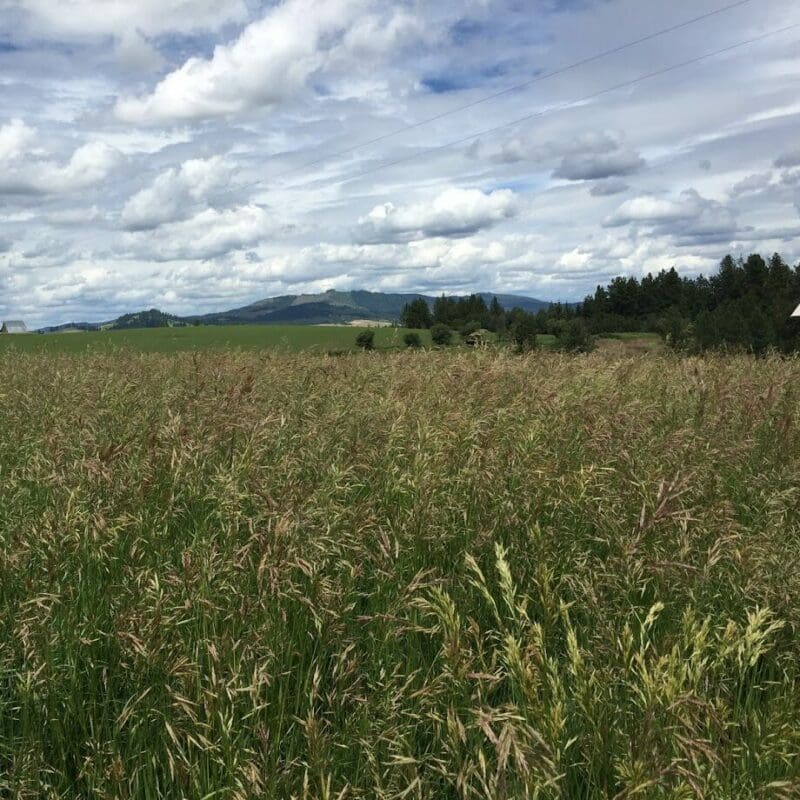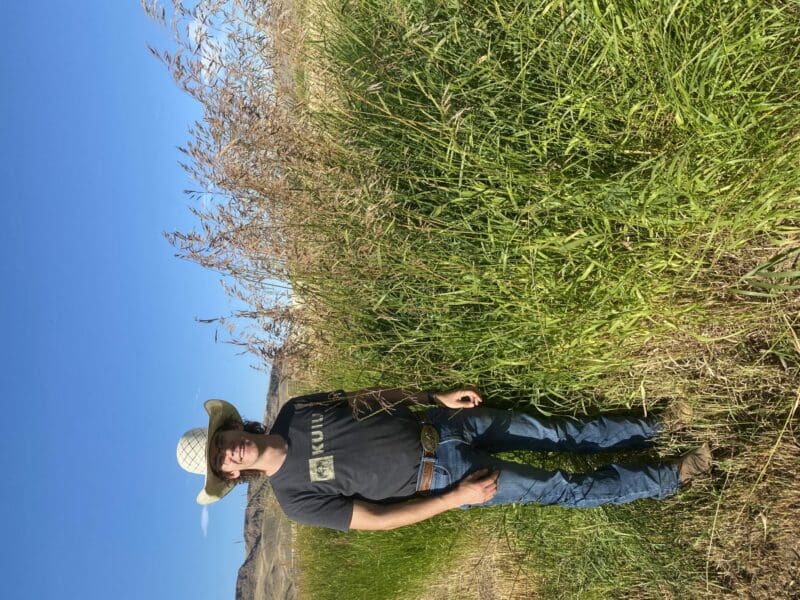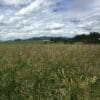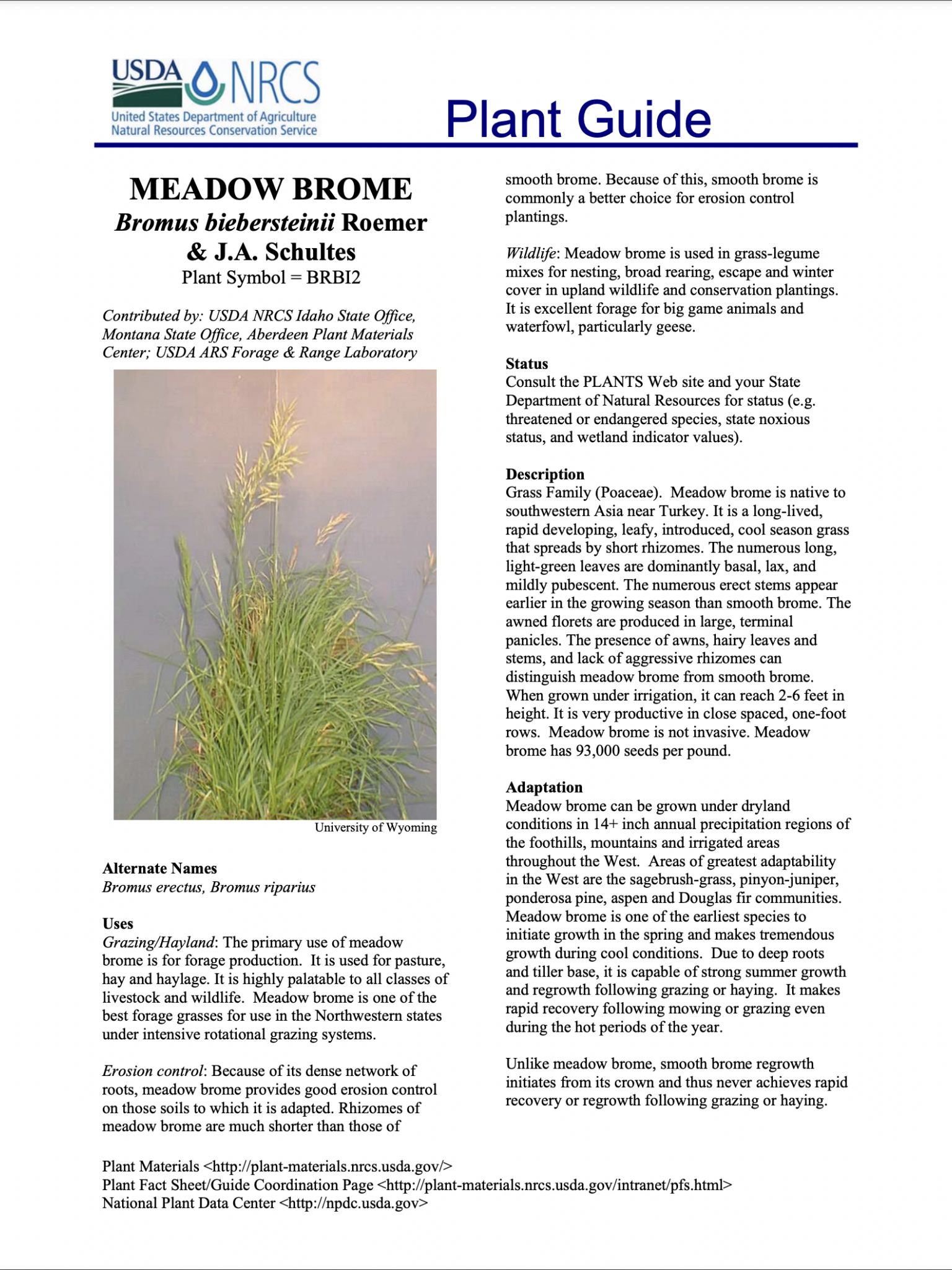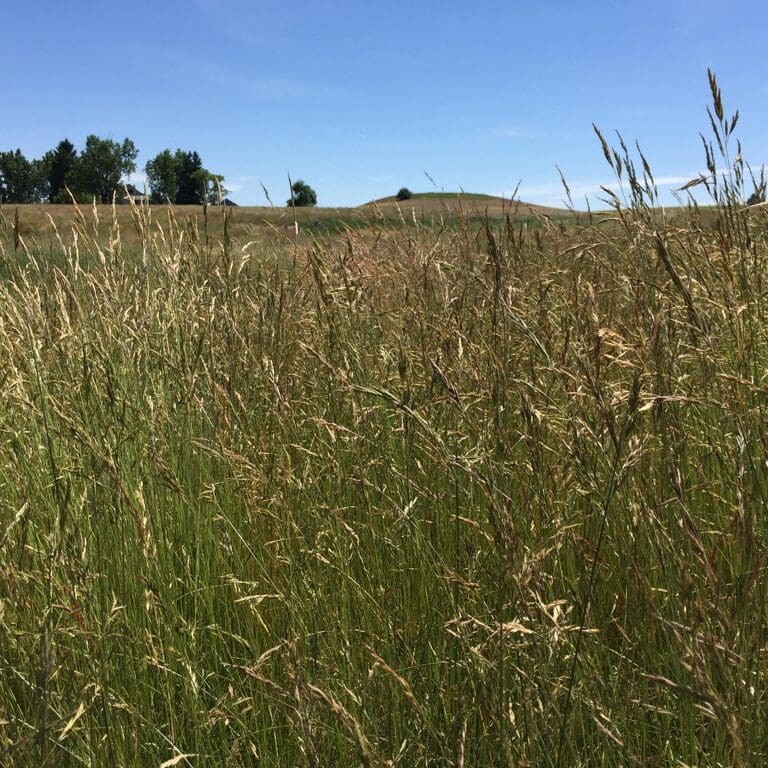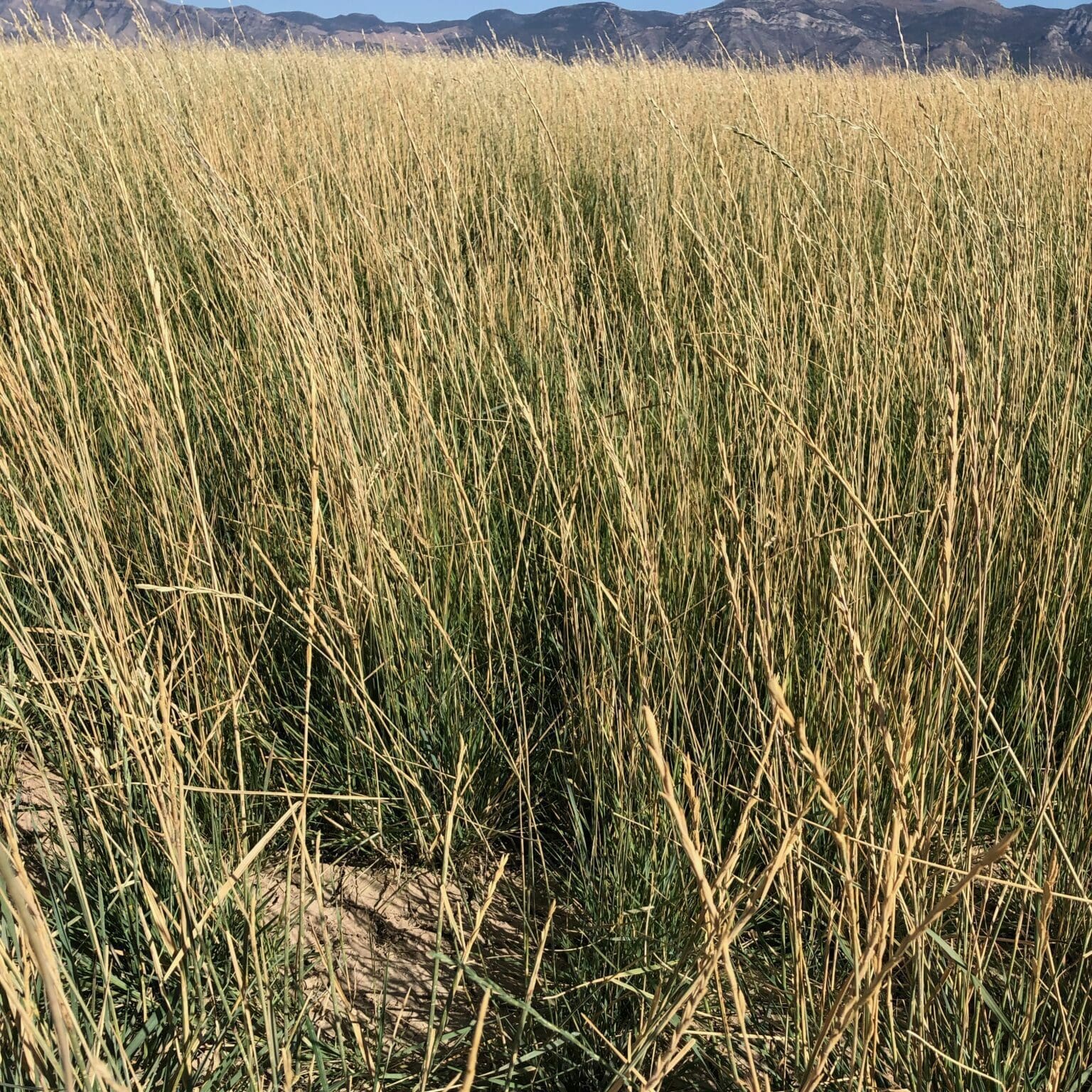Cache Meadow Brome
- Long lived cool season perennial
- Excellent forage for big game animals and waterfowl
- Recommended in grass-legume mixes
- Excellent for upland game and wildlife cover
- Less aggressive than Smooth Brome
- Highly palatable
- Widely used for hay, pasture and forage production
Cache Meadow Brome (Bromopsis biebersteinii) was developed by the USDA- ARS, Forage and Range Research Laboratory at Utah State University, Logan, UT. Released in 2004 with Plant Variety Protection (PVP). Cache Meadow Brome derived from selections of Regar, Fleet and Paddock. Selected for improved seedling establishment and increased forage yields on irrigated and semi-irrigated pastures in the Intermountain and Northern Great Plains regions of the western United States. Individual seed weight of Cache is comparable to Fleet and Paddock, but significantly heavier than Regar. Cache Meadow Brome is a favorite and is a standard item in our pasture grass mixes.
Meadow Brome (Meadow Bromegrass) (Bromopsis biebersteinii) is an introduced, long lived cool season perennial. Introduced to the United States from Turkey in 1949. It is highly palatable and widely used for hay, pasture and forage production. Meadow Brome is highly palatable to all classes of livestock and wildlife, Cache Meadow Brome is among the favorites. It provides good erosion control with its dense network of fibrous roots.
Meadow brome (Bromopsis biebersteinii) is most commonly used in the northern United States and southern parts of Canada but it can grow on plains, mountain valleys, mountain brush, aspen, conifer forest and subalpine sites at elevations above 3,000 feet. It has excellent winter hardiness with moderate tolerance to shade. It is less winter hardy than smooth brome and crested wheatgrass. It performs best on moderately deep to deep, fertile, well-drained soils but also performs fairly well on shallower soils. Preferred soil textures range from coarse gravelly to medium textured. Meadow brome can be grown under dryland conditions receiving greater than 14 inches of annual precipitation, but performs best with 16 inches or more of annual precipitation or with irrigation. Meadow brome is rated poor to moderate for salinity tolerance depending on testing procedures. It is sensitive to flooding and commonly dies if inundated for more than 10 days.
Excellent forage for big game animals and waterfowl. Recommended in grass-legume mixes. Excellent for nesting, brood rearing, escape, and winter cover in upland wildlife conservation plantings and field borders. Less aggressive than Smooth Brome.
Under dryland conditions Cache Meadow Brome plantings should not be grazed until late summer or fall of the second growing season. Plants are severely damaged or pulled out by overgrazing especially in the seedling year. Under irrigated conditions the new planting should not be grazed until late summer or fall of the first growing season. Harvesting for hay during the establishment year is most beneficial to eliminate grazing damage. This plant responds well to rotation- deferred grazing systems. Allowed to periodically mature and produce seed to maintain long-lived stands. Not considered weedy but could spread into adjoining degraded plant communities via seed under ideal conditions.
Other Meadow Brome Cultivars
‘Fleet’: Developed by the Agriculture Canada Research Station, Saskatoon, Saskatchewan and released in 1987. Formed as a synthetic of plants from Eurasian sources including Regar. Fleet also has varying degrees of pubescence similar to Regar. Regrowth following clipping or grazing and fall greenness are also similar to Regar. Forage yields are also similar to Regar, but Fleet may produce higher seed yields.
‘Paddock’: Selected by the Agriculture Canada Research Station, Saskatoon, Saskatchewan, Canada and released in 1987. Developed from an introduction from Krasnodar, USSR in 1969. Paddock has a similar habit of growth to Regar and Fleet. Leaves are slightly wider than Regar and forage yields are similar to Fleet and Regar. Paddock seed yields are greater than Regar seed yields.
‘Regar’: Selected from a collection made near Zek, in Kars Province in Turkey in 1949. Made available to the Aberdeen Plant Materials Center in 1957 by the USDA Regional Plant Introduction Station and released in 1966 by the Aberdeen, Idaho Plant Materials Center and the Idaho Agricultural Experiment Station. Regar seed germinates readily, seedling vigor is good and seedlings establish rapidly.
Synonyms: Bromus erectus, Bromus riparius
See USDA release notes here.
This product is a component of our Irrigated Pasture Mix.
***click on the “Quick Plant Facts” tab above for more information.
Meadow Brome NRCS Plant Guide and Fact Sheet
Meadow Brome NRCS Plant Guide and Fact Sheet
PDF version of NRCS Plant Guide and Fact Sheet
Prepared By: Dan Ogle, USDA NRCS Idaho State Office, Boise, Idaho
Loren St. John, USDA NRCS Plant Materials Center, Aberdeen, Idaho
Larry K. Holzworth, USDA NRCS Montana State
Office, Bozeman, Montana
Dr. Kevin B. Jensen, USDA ARS Forage and Range
Research Laboratory, Utah State University, Logan, Utah
Species Coordinator: Dan Ogle, USDA NRCS Idaho State Office, Boise, Idaho
Cache Meadow Brome Cultivar Spec Sheet
Cache Meadow Brome Cultivar Spec Sheet
PDF version of Cache Cultivar Spec Sheet
D.W. Mornhinweg,* L.H. Edwards,
Published in Crop Sci. 44:2262–2263 (2004).
E.L. Smith, G.H. Morgan, J.A. Webster,
D.R. Porter, and B.F. Carver
Helpful Links
Additional information about this product can be found on the academic websites linked below.
Synonyms
Many plants have more than one common and scientific name. We've listed a few of them below.
- Cache Meadow Brome
- Bromus biebersteinii
- Bromus erectus
- Bromus riparius
Who is Great Basin Seed?
Great Basin Seed is a seed company that specializes in seed sales and consultation for home, ranch, farm, range and reclamation. We have been a leader in the seed industry since 1974.
Our History
We've been in the seed business since 1974.
What We Offer
We offer seed for home, farm, ranch, range and reclamation projects.
Meet the Gang
We have the best employees in the world! We are proud of the work they do, and trust them to serve you!
Right: Company founder Lloyd and his wife Paula Stevens in a wildflower seed production field circa 1977
Quick Plant Facts
| Common Name: | Meadow Brome |
|---|---|
| Scientific Name: | |
| Origin: | |
| Plant Type: | |
| Lifespan: | |
| Seed Count | 40,000 seeds/lb. |
| Growth Season: | |
| Available Varieties: | |
| Sowing Rate | 10-12 PLS lbs. per Acre (double is broadcast) |
| Max Sowing Depth: | |
| Best Sowing Time | Fall, Spring |
| Growth Height: | |
| Min. Precipitation | 14 Inches Minimum |
| Root Form | Sodformer |
| Sun & Shade Tolerance: | High Sun |
| pH Tolerance: | |
| Elevation of Occurance: | |
| Hardiness Zones: |
